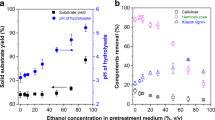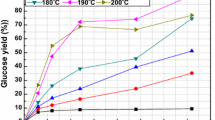Abstract
Pretreatment is the crucial step to disrupt the recalcitrant structure of lignocellulosic biomass for improving the enzymatic hydrolysis efficiency. Typically, hydrothermal, organosolv and hydrotropic pretreatments are environmentally benign and effective methods. In this work, effects of hydrothermal, organosolv and hydrotropic pretreatments on improving enzymatic hydrolysis of bamboo were comprehensively compared. Hydrotropic pretreatment was more effective in removal lignin and xylose from bamboo fiber cell wall. However, the surface coverage by lignin and extractives were dramatically displaced during organosolv pretreatment as investigation by X-ray photoelectron spectroscopy. After pretreatments, the crystallinity of cellulose in pretreated substrates has a significant reduction, and pores were exposed on fiber surface. The residual content of acetyl and phenolic groups in hydrotropic pretreated substrates is lower than organosolv pretreated substrates. In order to deeply assess the delignification of pretreatments, the isolated lignins obtaining from pretreatments process were characterized by Fourier transform infrared spectroscopy also. It was revealed that hydrotropic lignin contained more phenolic hydroxyl group and syringyl units than organosolv lignin. Compared to hydrothermal and organosolv pretreatment, cellulase adsorption capacity of pretreated substrates was notably improved by hydrotropic pretreatment, which indicating the better enzyme accessibility of cellulose. Eventually, the maximum glucose yield was obtained from hydrotropic pretreated substrates.






Similar content being viewed by others
References
Bradford MM (1976) A rapid and sensitive method for the quantitation of microgram quantities of protein utilizing the principle of protein-dye binding. Anal Biochem 72:248–254
Gabov K, Fardim P, da Silva Junior FG (2013) Hydrotropic fractionation of birch wood into cellulose and lignin: a new step towards green biorefinery. BioResources 8:3518–3531
Gouveia S, Fernandez-Costas C, Sanroman MA, Moldes D (2012) Enzymatic polymerisation and effect of fractionation of dissolved lignin from Eucalyptus globulus Kraft liquor. Bioresour Technol 121:131–138
Guo F, Shi W, Sun W et al (2014) Differences in the adsorption of enzymes onto lignins from diverse types of lignocellulosic biomass and the underlying mechanism. Biotechnol Biofuels 7:38
Hall M, Bansal P, Lee JH et al (2010) Cellulose crystallinity—a key predictor of the enzymatic hydrolysis rate. FEBS J 277(6):1571–1582
He MX, Wang JL, Han Q et al (2014) Bamboo: a new source of carbohydrate for biorefinery. Carbohydr Polym 111(20):645–654
Hurtubise FG, Krassig H (1960) Classification of fine structural characteristics in cellulose by infared spectroscopy: use of potassium bromide pellet technique. Anal Chem 32(2):177–181
Jäger G, Wu Z, Garschhammer K et al (2010) Practical screening of purified cellobiohydrolases and endoglucanases with α-cellulose and specification of hydrodynamics. Biotechnol Biofuels 3(1):18
Jung S, Foston M, Kalluri UC et al (2012) 3D chemical image using ToF-SIMS revealing the biopolymer component spatial and lateral distributions in biomass. Angew Chem Int Ed 51:12005–12008
Kim TH, Kim JS, Sunwoo C, Lee YY (2003) Pretreatment of corn stover by aqueous ammonia. Bioresour Technol 90:39–47
Kumar R, Wyman CE (2009) Cellulase adsorption and relationship to features of corn stover solids produced by leading pretreatments. Biotechnol Bioeng 103(2):252–267
Leenakul W, Tippayawong N (2010) Dilute acid pretreatment of bamboo for fermentable sugar production. J Sustain Energy Eng 1(3):117–120
Li Z, Jiang Z, Fei B et al (2012) Ethanol organosolve pretreatment of bamboo for efficient enzymatic saccharification. BioResources 7(3):3452–3462
Ma XJ, Cao SL, Lin L, Luo XL, Hu HC, Chen LH et al (2013) Hydrothermal pretreatment of bamboo and cellulose degradation. Bioresour Technol 148(7):408–413
Mooney CA, Mansfield SD, Touhy MG, Saddler JN (1998) The effect of initial pore volume and lignin content on the enzymatic hydrolysis of softwoods. Bioresour Technol 64(2):113–119
Mou HY, Orblin E, Kruus K, Fardim P (2013a) Topochemical pretreatment of wood biomass to enhance enzymatic hydrolysis of polysaccharides to sugars. Bioresour Technol 142:540–545
Mou HY, Heikkilä E, Fardim P (2013b) Topochemistry of alkaline, alkaline-peroxide and hydrotropic pretreatments of common reed to enhance enzymatic hydrolysis efficiency. Bioresour Technol 150:36–41
Mou HY, Heikkilä E, Fardim P (2014a) Topochemistry of environmental-friendly pretreatments to enhance enzymatic hydrolysis of sugarcane bagasse to fermentable sugar. J Agric Food Chem 62(16):3619–3625
Mou HY, Li B, Fardim P (2014b) Pretreatment of corn stover with the modified hydrotropic method to enhance enzymatic hydrolysis. Energy Fuels 28(7):4288–4293
Mou HY, Wu SB, Fardim P (2016) Applications of ToF-SIMS in surface chemistry analysis of lignocellulosic biomass: a review. BioResources 11(2):5581–5599
Nelson ML, O’Connor RT (1964) Relation of certain infrared bands to cellulose crystallinity and crystal lattice type, part I. Spectra of lattice types I, II, III and amorphous cellulose. J Appl Polym Sci 8:1325–1341
Ninomiya K, Soda H, Ogino C et al (2013) Effect of ionic liquid weight ratio on pretreatment of bamboo powder prior to enzymatic saccharification. Bioresour Technol 128(1):188–192
Pan XJ (2008) Role of functional groups in lignin inhibition of enzymatic hydrolysis of cellulose to glucose. J Biobased Mater Bioenergy 8:25–32
Pan XJ, Xie D, Gilkes N, Gregg DJ, Saddler JN (2005) Strategies to enhance the enzymatic hydrolysis of pretreated softwood with high residual lignin content. Appl Biochem Biotechnol 121–124:1069–1079
Peng H, Wang N, Hu Z et al (2012) Physicochemical characterization of hemicelluloses from bamboo (Phyllostachys pubescens mazel) stem. Ind Crop Prod 37(1):41–50
Qing Q, Zhou L, Huang M et al (2015) Improving enzymatic saccharification of bamboo shoot shell by alkalic salt pretreatment with H2O2. Bioresour Technol 201:230–236
Rahikainen JL, Martin-Sampedro R, Heikkinen H et al (2013) Inhibitory effect of lignin during cellulose bioconversion: the effect of lignin chemistry on non-productive enzyme adsorption. Bioresour Technol 133:270–278
Sathitsuksanoh N, Zhu Z, Ho TJ, Bai MD, Zhang YHP (2009) Bamboo saccharification through cellulose solvent-based biomass pretreatment followed by enzymatic hydrolysis at ultra-low cellulase loadings. Bioresour Technol 101(13):4926–4929
Scurlock JMO, Dayton DC, Hames B (2000) Bamboo: an overlooked biomass resource? Biomass Bioenergy 19:229–244
Segal L, Creely JJ, Martin AE, Conrad CM (1959) An empirical method for estimating the degree of crystallinity of native cellulose using the X-ray diffractometer. Text Res J 29:786–794
Sewalt VJH, Glasser WG, Beauchemin KA (1997) Lignin impact on fiber degradation. 3. Reversal of inhibition of enzymatic hydrolysis by chemical modification of lignin and by additives. J Agric Food Chem 45:1823–1828
Ström G, Carlsson J (1992) Wettability of kraft pulps-effects of surface composition and oxygen plasma treatment. J Adhes Sci Technol 6:745–761
Xiao X, Jing B, Li MF et al (2014) Enhanced enzymatic hydrolysis of bamboo (Dendrocalamus giganteus, munro) culm by hydrothermal pretreatment. Bioresour Technol 159(159):41–47
Xing Y, Yu H, Zhu L, Jiang J (2013) Efficient enzymatic hydrolysis of bamboo by pretreatment with steam explosion and alkaline peroxide. BioResources 8(4):5392–5408
Yamashita Y, Shono M, Sasaki C, Nakamura Y (2010) Alkaline peroxide pretreatment for efficient enzymatic saccharification of bamboo. Carbohydr Polym 79(4):914–920
Zhang YH (2008) Reviving the carbohydrate economy via multiproduct lignocellulosics biorefineries. J Ind Microbiol Biotechnol 35:367–375
Zhang JH, Tang M, Viikari L (2012) Xylans inhibit enzymatic hydrolysis of lignocellulosic materials by cellulases. Bioresour Technol 121:8–12
Zhang K, Pei ZJ, Wang DH (2016) Organic solvent pretreatment of lignocellulosic biomass for biofuels and biochemicals: a review. Bioresour Technol 199:21–33
Acknowledgements
This study was financially supported by Chinese National Natural Science (31600469), Foundation China Postdoctoral Science Foundation (2016M592494) and State Key Laboratory of Pulp and Paper Engineering (201530).
Author information
Authors and Affiliations
Corresponding author
Rights and permissions
About this article
Cite this article
Mou, H., Wu, S. Comparison of hydrothermal, hydrotropic and organosolv pretreatment for improving the enzymatic digestibility of bamboo. Cellulose 24, 85–94 (2017). https://doi.org/10.1007/s10570-016-1117-5
Received:
Accepted:
Published:
Issue Date:
DOI: https://doi.org/10.1007/s10570-016-1117-5




